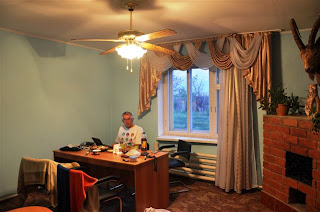 |
| Many villages & towns have elaborate sign posts at their entrance, this is the one for Karamendi for the Naurzum reserve |
 |
| Mike attempts to go on line in the reserve guest house |
 |
| Whilst Carol was photographing these 3 ticks their mates all jumped into one of her shoes (see previous post) |
 |
| The warden's garden |
 |
| Mike spots something rare - or so he reckoned |
 |
| There are many shallow, saline basins in the reserve - they were particularly low when we visited after 3 very dry years |
 |
| Mature pine forest in the reserve |
 |
| Fresh water lake - where we saw 2000 Red-necked Phalaropes |
We arrived in the village of Karamendi looking for the Naurzum Nature Reserve in mid afternoon on the 21st and whilst trying to find it we misread the sign for the Naurzum electricity office. There was quite a lot of confusion on everyone’s part about what we actually were doing in that office but a call to Mike’s contact Evgeny soon sorted it all out, embarrassment all round! In the meantime the electricity office staff ushered us into a common room for tea with various members of staff who quizzed us about our trip. When we asked how we could get to the reserve office we were told that in a few minutes someone would come for us. Sure enough one of the scientists there, Kanat, came over with a hastily found translator, Botagoz, from the local school, and they took us to the reserve HQ nearby. Botagoz, at only 16 years old, spoke excellent English, mostly self taught - she wants to study English & Chinese at university and become an interpreter. With Kazakh and fluent Russian already we feel she will do very well.
Having arrived we were given a tour and shown photos etc whilst we waited for the Assistant Director Maria Zinyelova to come and sort out our passes and some accommodation for the night. We then stayed in one of the centre’s guests houses so we could shower and recharge all our batteries, that’s literally, we need access to mains electricity every 10 days or so. We had also hoped to post a blog but the signal wasn’t good enough.
The next morning we were met by Maria, Kanat & Kseniya another young woman who spoke good English. She acted as our interpreter for the morning and came with us to the Centre’s house about 10km into the reserve. There we were able to park up in the back garden for three more nights under the care of Albakir one of the wardens & his wife. They were very kind (see Coeliac/food page) and we had use of their outdoor loo (long drop) and shower which provided warm water by solar radiation.
The Naurzum reserve was established 80 years ago in 1931 but it has seen various changes of direction over the years depending on the soviet regime of the time. At one point it was closed down and at others the local Commissars interfered with management on political lines. There are plantations of alien tress in the reserve which originate from this era. Today the reserve is split into three main study areas and the zone between has farming and herding activities compatible with the objectives of the reserve. The total area of main reserves and control areas is over 200,000 ha.
We visited the main ‘Naurzum’ section based on the village of that name. The main habitats in this section are ungrazed steppe grassland and heath, conifer woodland, birch and poplar woodland, saline lakes and dry basins, and freshwater lakes and ponds. There are a number of springs and small streams in the reserve but no significant rivers. Introduced trees in plantations are similar to those seen elsewhere in Kazakhstan, mainly a sort of elm (judging by the leaf and bark or it may be a hornbeam). Most are dead or dying from lack of water. There are also lines of conifers (which may be alien) planted some years ago. There are very few tracks within the reserve and the level of disturbance seemed light.
This part of Kazakhstan being positioned between the east and west palearctic regions, receiving northern visitors and adjacent to the Indian subcontinent, will inevitably have a huge list of birds. Since records began here 340 species have been recorded but as might be imagined many are vagrants to the region. We had some of the reserve specialities such as Imperial Eagle and Little Bustard but we did not see the Sociable Lapwings that breeds in the park. One notable observation was a flock of over 2000 Red-necked Phalarope on a fresh water lake on 23 May, but the next day they had all gone.
Many thanks to Evgeny Bragin for showing us some eagle nests in the reserve and an elk (moose), the only large animal we had seen there although several others are known including Red Deer, Wolf and Wild boar. Some more details of birds seen at the reserve are shown on the file sharing site mentioned on the bird page.
 |
| There is a beautiful grass in the reserve, and much of the steppe generally, which has long, trailing filaments which look like hair blowing in the wind |
 |
| Two mature pine trees |
 |
| View from the warden's garden |
 |
| Mike goes for a solar assisted warm shower |
 |
| Mike with Kanat and Botagoz |
 |
| Carol with Botagoz and butterfly |
 |
| Kseniy, Maria Zinyelova (Deputy Director) and Mike |
 |
| Our latest adoptee - another dog with no name |
 |
| Carol gets the bug |